2013 BMW 535I GRAN TURISMO wheel size
[x] Cancel search: wheel sizePage 110 of 240
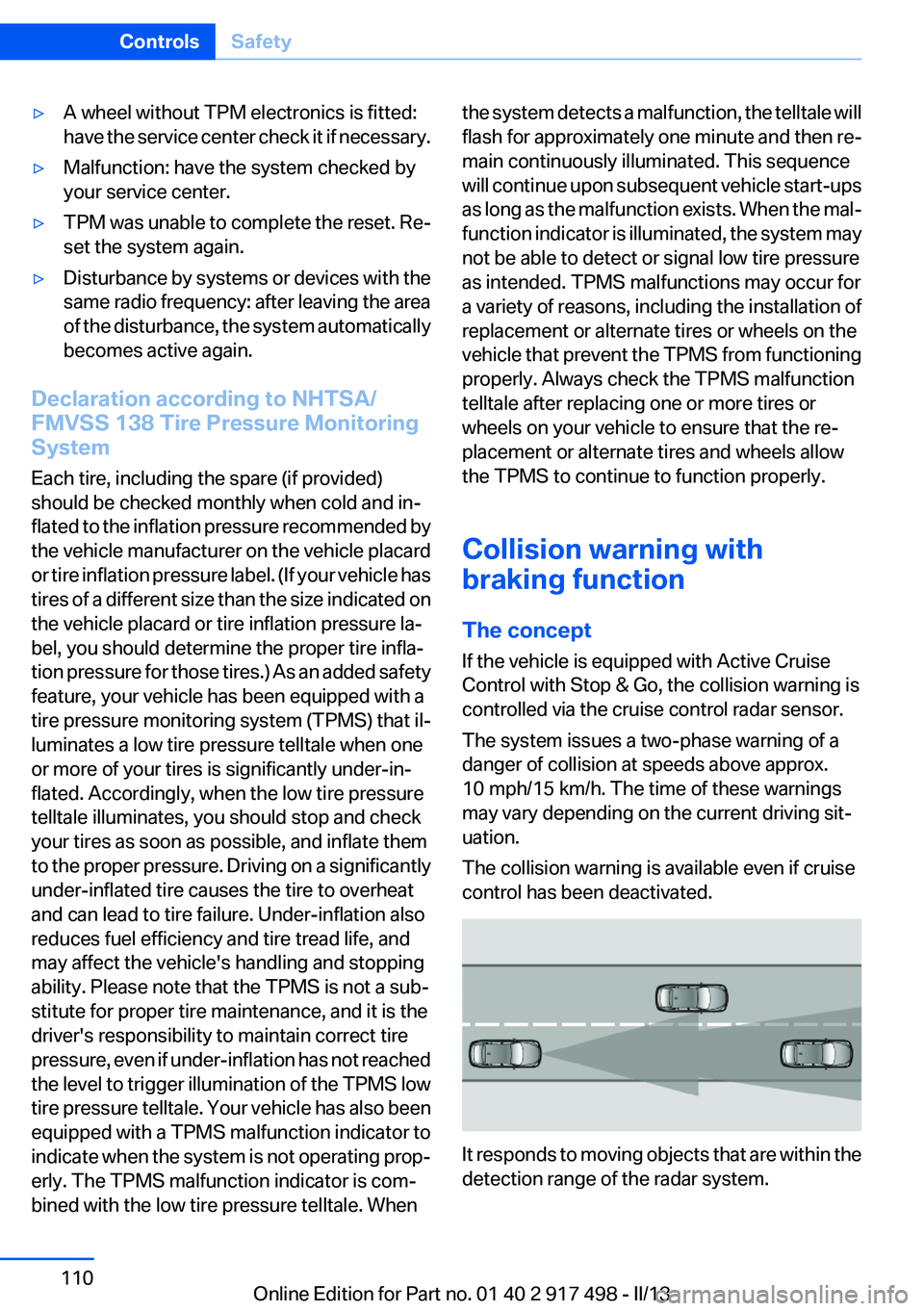
▷A wheel without TPM electronics is fitted:
have the service center check it if necessary.▷Malfunction: have the system checked by
your service center.▷TPM was unable to complete the reset. Re‐
set the system again.▷Disturbance by systems or devices with the
same radio frequency: after leaving the area
of the disturbance, the system automatically
becomes active again.
Declaration according to NHTSA/
FMVSS 138 Tire Pressure Monitoring
System
Each tire, including the spare (if provided)
should be checked monthly when cold and in‐
flated to the inflation pressure recommended by
the vehicle manufacturer on the vehicle placard
or tire inflation pressure label. (If your vehicle has
tires of a different size than the size indicated on
the vehicle placard or tire inflation pressure la‐
bel, you should determine the proper tire infla‐
tion pressure for those tires.) As an added safety
feature, your vehicle has been equipped with a
tire pressure monitoring system (TPMS) that il‐
luminates a low tire pressure telltale when one
or more of your tires is significantly under-in‐
flated. Accordingly, when the low tire pressure
telltale illuminates, you should stop and check
your tires as soon as possible, and inflate them
to the proper pressure. Driving on a significantly
under-inflated tire causes the tire to overheat
and can lead to tire failure. Under-inflation also
reduces fuel efficiency and tire tread life, and
may affect the vehicle's handling and stopping
ability. Please note that the TPMS is not a sub‐
stitute for proper tire maintenance, and it is the
driver's responsibility to maintain correct tire
pressure, even if under-inflation has not reached
the level to trigger illumination of the TPMS low
tire pressure telltale. Your vehicle has also been
equipped with a TPMS malfunction indicator to
indicate when the system is not operating prop‐
erly. The TPMS malfunction indicator is com‐
bined with the low tire pressure telltale. When
the system detects a malfunction, the telltale will
flash for approximately one minute and then re‐
main continuously illuminated. This sequence
will continue upon subsequent vehicle start-ups
as long as the malfunction exists. When the mal‐
function indicator is illuminated, the system may
not be able to detect or signal low tire pressure
as intended. TPMS malfunctions may occur for
a variety of reasons, including the installation of
replacement or alternate tires or wheels on the
vehicle that prevent the TPMS from functioning
properly. Always check the TPMS malfunction
telltale after replacing one or more tires or
wheels on your vehicle to ensure that the re‐
placement or alternate tires and wheels allow
the TPMS to continue to function properly.
Collision warning with
braking function
The concept
If the vehicle is equipped with Active Cruise
Control with Stop & Go, the collision warning is
controlled via the cruise control radar sensor.
The system issues a two-phase warning of a
danger of collision at speeds above approx.
10 mph/15 km/h. The time of these warnings
may vary depending on the current driving sit‐
uation.
The collision warning is available even if cruise
control has been deactivated.
It responds to moving objects that are within the
detection range of the radar system.
Seite 110ControlsSafety110
Online Edition for Part no. 01 40 2 917 498 - II/13
Page 191 of 240
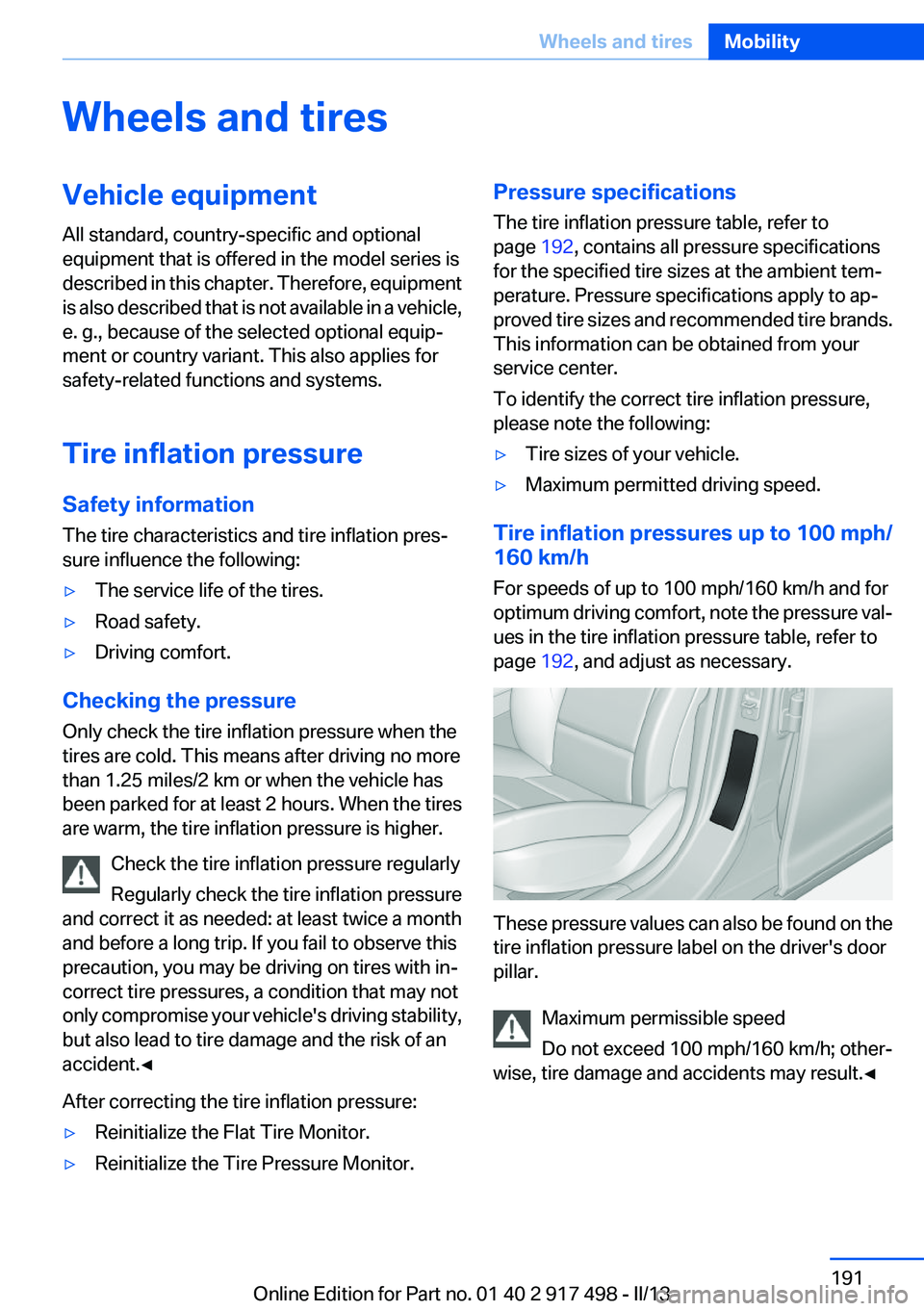
Wheels and tiresVehicle equipment
All standard, country-specific and optional
equipment that is offered in the model series is
described in this chapter. Therefore, equipment
is also described that is not available in a vehicle,
e. g., because of the selected optional equip‐
ment or country variant. This also applies for
safety-related functions and systems.
Tire inflation pressure
Safety information
The tire characteristics and tire inflation pres‐
sure influence the following:▷The service life of the tires.▷Road safety.▷Driving comfort.
Checking the pressure
Only check the tire inflation pressure when the
tires are cold. This means after driving no more
than 1.25 miles/2 km or when the vehicle has
been parked for at least 2 hours. When the tires
are warm, the tire inflation pressure is higher.
Check the tire inflation pressure regularly
Regularly check the tire inflation pressure
and correct it as needed: at least twice a month
and before a long trip. If you fail to observe this
precaution, you may be driving on tires with in‐
correct tire pressures, a condition that may not
only compromise your vehicle's driving stability,
but also lead to tire damage and the risk of an
accident.◀
After correcting the tire inflation pressure:
▷Reinitialize the Flat Tire Monitor.▷Reinitialize the Tire Pressure Monitor.Pressure specifications
The tire inflation pressure table, refer to
page 192, contains all pressure specifications
for the specified tire sizes at the ambient tem‐
perature. Pressure specifications apply to ap‐
proved tire sizes and recommended tire brands.
This information can be obtained from your
service center.
To identify the correct tire inflation pressure,
please note the following:▷Tire sizes of your vehicle.▷Maximum permitted driving speed.
Tire inflation pressures up to 100 mph/
160 km/h
For speeds of up to 100 mph/160 km/h and for
optimum driving comfort, note the pressure val‐
ues in the tire inflation pressure table, refer to
page 192, and adjust as necessary.
These pressure values can also be found on the
tire inflation pressure label on the driver's door
pillar.
Maximum permissible speed
Do not exceed 100 mph/160 km/h; other‐
wise, tire damage and accidents may result.◀
Seite 191Wheels and tiresMobility191
Online Edition for Part no. 01 40 2 917 498 - II/13
Page 192 of 240
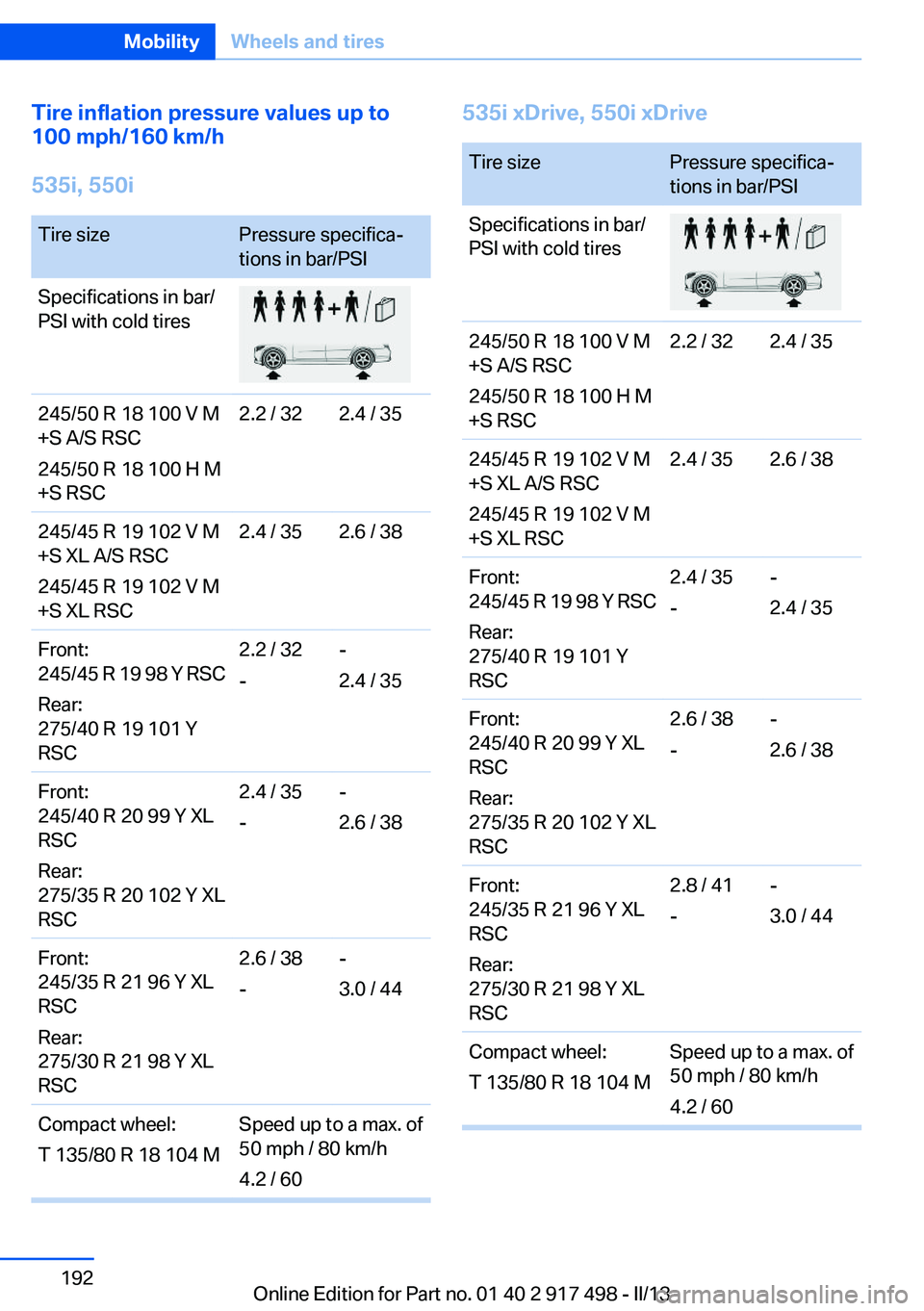
Tire inflation pressure values up to
100 mph/160 km/h
535i, 550iTire sizePressure specifica‐
tions in bar/PSISpecifications in bar/
PSI with cold tires245/50 R 18 100 V M
+S A/S RSC
245/50 R 18 100 H M
+S RSC2.2 / 322.4 / 35245/45 R 19 102 V M
+S XL A/S RSC
245/45 R 19 102 V M
+S XL RSC2.4 / 352.6 / 38Front:
245/45 R 19 98 Y RSC
Rear:
275/40 R 19 101 Y
RSC2.2 / 32
--
2.4 / 35Front:
245/40 R 20 99 Y XL
RSC
Rear:
275/35 R 20 102 Y XL
RSC2.4 / 35
--
2.6 / 38Front:
245/35 R 21 96 Y XL
RSC
Rear:
275/30 R 21 98 Y XL
RSC2.6 / 38
--
3.0 / 44Compact wheel:
T 135/80 R 18 104 MSpeed up to a max. of
50 mph / 80 km/h
4.2 / 60535i xDrive, 550i xDriveTire sizePressure specifica‐
tions in bar/PSISpecifications in bar/
PSI with cold tires245/50 R 18 100 V M
+S A/S RSC
245/50 R 18 100 H M
+S RSC2.2 / 322.4 / 35245/45 R 19 102 V M
+S XL A/S RSC
245/45 R 19 102 V M
+S XL RSC2.4 / 352.6 / 38Front:
245/45 R 19 98 Y RSC
Rear:
275/40 R 19 101 Y
RSC2.4 / 35
--
2.4 / 35Front:
245/40 R 20 99 Y XL
RSC
Rear:
275/35 R 20 102 Y XL
RSC2.6 / 38
--
2.6 / 38Front:
245/35 R 21 96 Y XL
RSC
Rear:
275/30 R 21 98 Y XL
RSC2.8 / 41
--
3.0 / 44Compact wheel:
T 135/80 R 18 104 MSpeed up to a max. of
50 mph / 80 km/h
4.2 / 60Seite 192MobilityWheels and tires192
Online Edition for Part no. 01 40 2 917 498 - II/13
Page 193 of 240
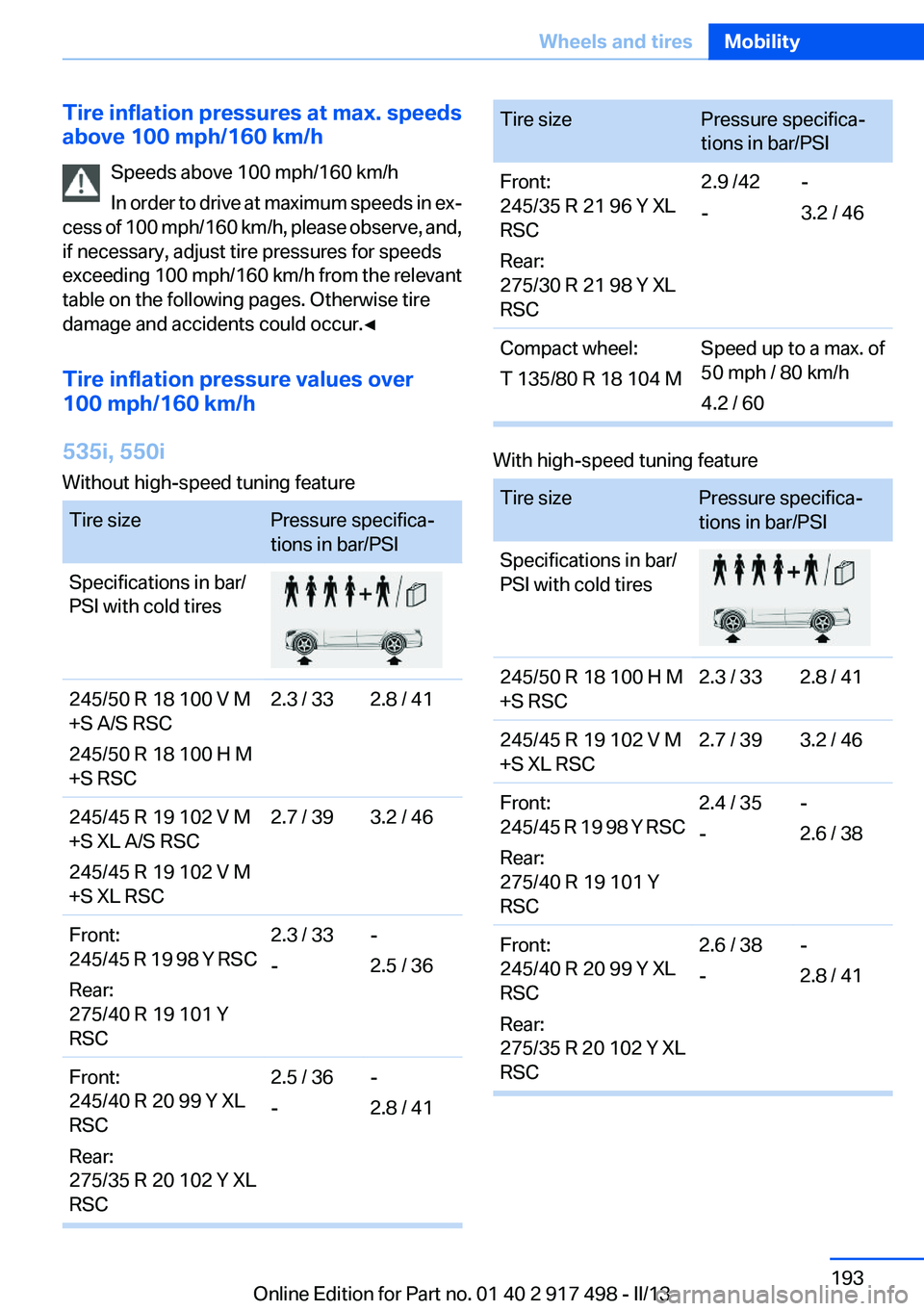
Tire inflation pressures at max. speeds
above 100 mph/160 km/h
Speeds above 100 mph/160 km/h
In order to drive at maximum speeds in ex‐
cess of 100 mph/160 km/h, please observe, and,
if necessary, adjust tire pressures for speeds
exceeding 100 mph/160 km/h from the relevant
table on the following pages. Otherwise tire
damage and accidents could occur.◀
Tire inflation pressure values over
100 mph/160 km/h
535i, 550i
Without high-speed tuning featureTire sizePressure specifica‐
tions in bar/PSISpecifications in bar/
PSI with cold tires245/50 R 18 100 V M
+S A/S RSC
245/50 R 18 100 H M
+S RSC2.3 / 332.8 / 41245/45 R 19 102 V M
+S XL A/S RSC
245/45 R 19 102 V M
+S XL RSC2.7 / 393.2 / 46Front:
245/45 R 19 98 Y RSC
Rear:
275/40 R 19 101 Y
RSC2.3 / 33
--
2.5 / 36Front:
245/40 R 20 99 Y XL
RSC
Rear:
275/35 R 20 102 Y XL
RSC2.5 / 36
--
2.8 / 41Tire sizePressure specifica‐
tions in bar/PSIFront:
245/35 R 21 96 Y XL
RSC
Rear:
275/30 R 21 98 Y XL
RSC2.9 /42
--
3.2 / 46Compact wheel:
T 135/80 R 18 104 MSpeed up to a max. of
50 mph / 80 km/h
4.2 / 60
With high-speed tuning feature
Tire sizePressure specifica‐
tions in bar/PSISpecifications in bar/
PSI with cold tires245/50 R 18 100 H M
+S RSC2.3 / 332.8 / 41245/45 R 19 102 V M
+S XL RSC2.7 / 393.2 / 46Front:
245/45 R 19 98 Y RSC
Rear:
275/40 R 19 101 Y
RSC2.4 / 35
--
2.6 / 38Front:
245/40 R 20 99 Y XL
RSC
Rear:
275/35 R 20 102 Y XL
RSC2.6 / 38
--
2.8 / 41Seite 193Wheels and tiresMobility193
Online Edition for Part no. 01 40 2 917 498 - II/13
Page 194 of 240

Tire sizePressure specifica‐
tions in bar/PSIFront:
245/35 R 21 96 Y XL
RSC
Rear:
275/30 R 21 98 Y XL
RSC2.9 /42
--
3.3 / 48Compact wheel:
T 135/80 R 18 104 MSpeed up to a max. of
50 mph / 80 km/h
4.2 / 60
535i xDrive, 550i xDrive
Without high-speed tuning feature
Tire sizePressure specifica‐
tions in bar/PSISpecifications in bar/
PSI with cold tires245/50 R 18 100 V M
+S A/S RSC
245/50 R 18 100 H M
+S RSC2.3 / 332.7 / 39245/45 R 19 102 V M
+S XL A/S RSC
245/45 R 19 102 V M
+S XL RSC2.5 / 362.9 /42Front:
245/45 R 19 98 Y RSC
Rear:
275/40 R 19 101 Y
RSC2.4 / 35
--
2.4 / 35Front:
245/40 R 20 99 Y XL
RSC
Rear:
275/35 R 20 102 Y XL
RSC2.6 / 38
--
2.6 / 38Tire sizePressure specifica‐
tions in bar/PSIFront:
245/35 R 21 96 Y XL
RSC
Rear:
275/30 R 21 98 Y XL
RSC2.8 / 41
--
3.0 / 44Compact wheel:
T 135/80 R 18 104 MSpeed up to a max. of
50 mph / 80 km/h
4.2 / 60
With high-speed tuning feature
Tire sizePressure specifica‐
tions in bar/PSISpecifications in bar/
PSI with cold tires245/50 R 18 100 H M
+S RSC2.5 / 362.8 / 41245/45 R 19 102 V M
+S XL A/S RSC
245/45 R 19 102 V M
+S XL RSC2.8 / 413.2 / 46Front:
245/45 R 19 98 Y RSC
Rear:
275/40 R 19 101 Y
RSC2.5 / 36
--
2.5 / 36Front:
245/40 R 20 99 Y XL
RSC
Rear:
275/35 R 20 102 Y XL
RSC2.8 / 41
--
2.8 / 41Seite 194MobilityWheels and tires194
Online Edition for Part no. 01 40 2 917 498 - II/13
Page 195 of 240
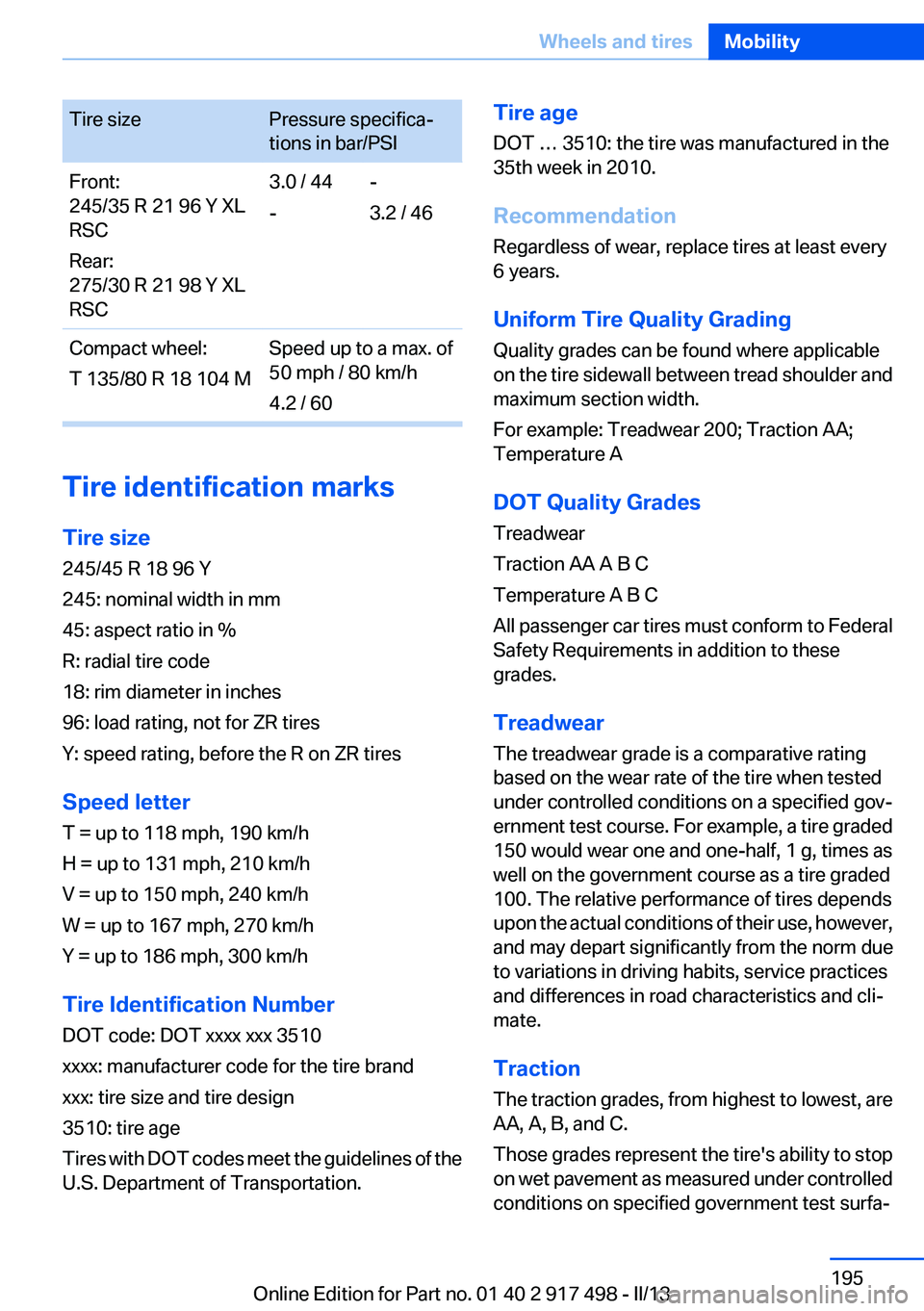
Tire sizePressure specifica‐
tions in bar/PSIFront:
245/35 R 21 96 Y XL
RSC
Rear:
275/30 R 21 98 Y XL
RSC3.0 / 44
--
3.2 / 46Compact wheel:
T 135/80 R 18 104 MSpeed up to a max. of
50 mph / 80 km/h
4.2 / 60
Tire identification marks
Tire size
245/45 R 18 96 Y
245: nominal width in mm
45: aspect ratio in %
R: radial tire code
18: rim diameter in inches
96: load rating, not for ZR tires
Y: speed rating, before the R on ZR tires
Speed letter
T = up to 118 mph, 190 km/h
H = up to 131 mph, 210 km/h
V = up to 150 mph, 240 km/h
W = up to 167 mph, 270 km/h
Y = up to 186 mph, 300 km/h
Tire Identification Number
DOT code: DOT xxxx xxx 3510
xxxx: manufacturer code for the tire brand
xxx: tire size and tire design
3510: tire age
Tires with DOT codes meet the guidelines of the
U.S. Department of Transportation.
Tire age
DOT … 3510: the tire was manufactured in the
35th week in 2010.
Recommendation
Regardless of wear, replace tires at least every
6 years.
Uniform Tire Quality Grading
Quality grades can be found where applicable
on the tire sidewall between tread shoulder and
maximum section width.
For example: Treadwear 200; Traction AA;
Temperature A
DOT Quality Grades
Treadwear
Traction AA A B C
Temperature A B C
All passenger car tires must conform to Federal
Safety Requirements in addition to these
grades.
Treadwear
The treadwear grade is a comparative rating
based on the wear rate of the tire when tested
under controlled conditions on a specified gov‐
ernment test course. For example, a tire graded
150 would wear one and one-half, 1 g, times as
well on the government course as a tire graded
100. The relative performance of tires depends
upon the actual conditions of their use, however,
and may depart significantly from the norm due
to variations in driving habits, service practices
and differences in road characteristics and cli‐
mate.
Traction
The traction grades, from highest to lowest, are
AA, A, B, and C.
Those grades represent the tire's ability to stop
on wet pavement as measured under controlled
conditions on specified government test surfa‐Seite 195Wheels and tiresMobility195
Online Edition for Part no. 01 40 2 917 498 - II/13
Page 197 of 240
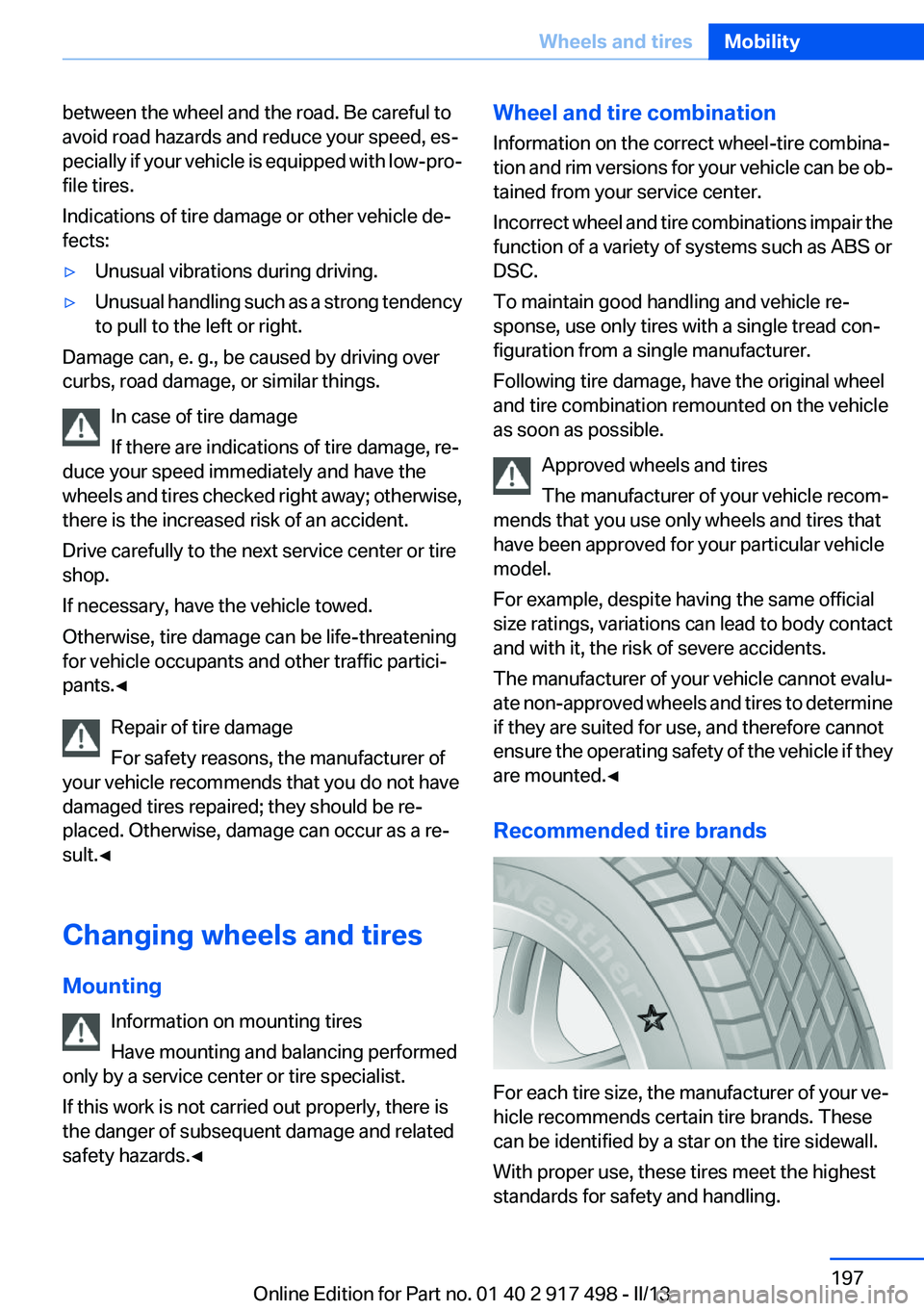
between the wheel and the road. Be careful to
avoid road hazards and reduce your speed, es‐
pecially if your vehicle is equipped with low-pro‐
file tires.
Indications of tire damage or other vehicle de‐
fects:▷Unusual vibrations during driving.▷Unusual handling such as a strong tendency
to pull to the left or right.
Damage can, e. g., be caused by driving over
curbs, road damage, or similar things.
In case of tire damage
If there are indications of tire damage, re‐
duce your speed immediately and have the
wheels and tires checked right away; otherwise,
there is the increased risk of an accident.
Drive carefully to the next service center or tire
shop.
If necessary, have the vehicle towed.
Otherwise, tire damage can be life-threatening
for vehicle occupants and other traffic partici‐
pants.◀
Repair of tire damage
For safety reasons, the manufacturer of
your vehicle recommends that you do not have
damaged tires repaired; they should be re‐
placed. Otherwise, damage can occur as a re‐
sult.◀
Changing wheels and tires
Mounting Information on mounting tires
Have mounting and balancing performed
only by a service center or tire specialist.
If this work is not carried out properly, there is
the danger of subsequent damage and related
safety hazards.◀
Wheel and tire combination
Information on the correct wheel-tire combina‐
tion and rim versions for your vehicle can be ob‐
tained from your service center.
Incorrect wheel and tire combinations impair the
function of a variety of systems such as ABS or
DSC.
To maintain good handling and vehicle re‐
sponse, use only tires with a single tread con‐
figuration from a single manufacturer.
Following tire damage, have the original wheel
and tire combination remounted on the vehicle
as soon as possible.
Approved wheels and tires
The manufacturer of your vehicle recom‐
mends that you use only wheels and tires that
have been approved for your particular vehicle
model.
For example, despite having the same official
size ratings, variations can lead to body contact
and with it, the risk of severe accidents.
The manufacturer of your vehicle cannot evalu‐
ate non-approved wheels and tires to determine
if they are suited for use, and therefore cannot
ensure the operating safety of the vehicle if they
are mounted.◀
Recommended tire brands
For each tire size, the manufacturer of your ve‐
hicle recommends certain tire brands. These
can be identified by a star on the tire sidewall.
With proper use, these tires meet the highest
standards for safety and handling.
Seite 197Wheels and tiresMobility197
Online Edition for Part no. 01 40 2 917 498 - II/13
Page 199 of 240

Changing run-flat tires
For your own safety, only use run-flat tires. No
spare tire is available in the case of a flat tire. Your
service center will be glad to advise you.
Snow chains
Fine-link snow chains
Only certain types of fine-link snow chains have
been tested by the manufacturer of your vehicle,
classified as road-safe and recommended.
Consult your service center for more informa‐
tion.
Use
Use only in pairs on the rear wheels, equipped
with the tires of the following size:▷245/50 R 18.▷245/45 R 19.
Follow the chain manufacturer's instructions.
Make sure that the snow chains are always suf‐
ficiently tight. Retighten as needed according to
the chain manufacturer's instructions.
Do not initialize the Flat Tire Monitor after
mounting snow chains, as doing so may result
in incorrect readings.
Do not initialize the Tire Pressure Monitor after
mounting snow chains, as doing so may result
in incorrect readings.
When driving with snow chains, briefly activate
Dynamic Traction Control if necessary.
Maximum speed with snow chains
Do not exceed a speed of 30 mph/50 km/h when
using snow chains.
Snow chain detection
The concept
When using snow chains, you should set
whether you are driving with or without snow
chains via the iDrive.
The snow chain detection system supports you
by automatically showing the detected state on
the Control Display.
When snow chains are in use, the rear axle steer‐
ing of the Integral Active Steering is deactivated
automatically.
At speeds above the maximum permitted speed
with snow chains of 30 mph/50 km/h, the rear
axle steering is activated again automatically.
Activating the status1."Settings"2."Tire chains"3."Tire chains installed"
Automatic detection
If functioning properly:
▷Snow chains are mounted. The setting is not
activated
.
After you drive a short distance, a Check
Control message is shown and the state is
activated automatically.
Confirm the automatic activation.
▷Snow chains are not mounted. The setting
is activated
.
At speeds above 30 mph/50 km/h, a Check
Control message is displayed. Deactivate
the status manually.
If not functioning properly:
▷Snow chains are mounted. The setting is not
activated
.
A Check Control message is not displayed.
The automatic detection system is malfunc‐
tioning. Activate the status manually.
Activating/deactivating rear axle
steering
If the status indicating that snow chains are in
use is activated, the rear axle steering is deacti‐
vated automatically.
Seite 199Wheels and tiresMobility199
Online Edition for Part no. 01 40 2 917 498 - II/13